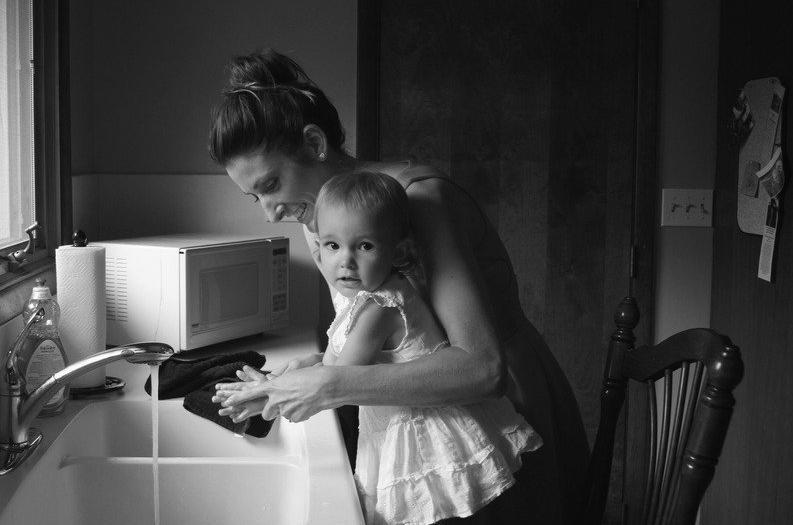Postpartum OCD

- posted: Sep. 26, 2023
WHY am I thinking that!?!
When my girls were babies I was acutely aware of how fragile their little bodies were. I imagined what would happen to them if they flew out of the car window on the highway. I pictured what it would look like to trip on the stairs and fall on top of them. Then I did trip going down the stairs, and found that I automatically protected my baby by holding her tight and leaning backwards. Without having my arms to break the fall my body took the full brunt. We landed at the bottom and both started crying. My back was sore for weeks, but the image of crushing her in a fall never returned.
Do you ever have scary or disturbing thoughts or images run through your mind? Images of bad things happening to your precious little one? Or something harmful happening to you leaving you unable to care for your baby? Be honest. If you are, the answer will probably be yes, as about 98% of parents have such thoughts occasionally. Most shiver at the thought and then move on to something else.
For some, however, these thoughts are followed with intense self-doubt and anxiety. Questions come up such as “What does it mean that I thought that? What if that really happened? Do I secretly want that to happen? I really need to make sure that doesn’t happen!” Because of those questions, you pay extra attention, staying alert to that thought showing up again. Kind of like if I told you not to think of a blue dinosaur, what immediately comes to mind? Right, a blue dinosaur.
Obsessions
This is an especially torturous form of postpartum anxiety disorder called Postpartum Obsessive Compulsive Disorder. Obsessive thoughts are often about the things we most value, so of course during pregnancy and the postpartum period they are often about our children or our ability to care for them. Anxiety triggers (obsessions) may take many forms — thoughts/images about dropping the baby, about touching the baby inappropriately during a diaper change, about baby becoming ill because of germs, about baby not breathing, about accidentally leaving baby in the car to name a few. Sometimes they are not about baby at all, but instead are about your own health, spouse’s fidelity, perfectionism, sexuality, spirituality, rules, even body functions such as swallowing or breathing. No matter what they are about, the thoughts feel dangerous and trigger high anxiety.
Compulsions
What is the logical thing to do when something feels dangerous or scary? Check to make sure it is safe, change it so it is safe, or avoid it altogether, right? (Hint: this is a trick question!). People with OCD will go to great lengths to avoid reminders or to take action to temporarily decrease their anxiety (compulsions). The urge to do the compulsion feels so strong that people often say they can’t NOT do it. Compulsions can look like checking multiple times that the car seat is buckled properly before leaving, spending hours a day googling health symptoms, or waking the baby to make sure he is breathing. It can look like asking friends and family for reassurance so often that they get annoyed because they see that the worries come right back. Avoidance can be making sure you are never alone with your little one, insisting that your partner always give the baths, or a million other things. Compulsions and efforts at avoidance are as varied as the fears that trigger them.
Like the blue dinosaur, the more effort involved in doing compulsions or avoiding, the more awareness that the thoughts exist, and the more frequent they become. Eventually, managing anxiety and doing compulsions can take over your life. It is a vicious and torturous cycle that can make even the most mundane activity take enormous amounts of mental effort. It is emotionally exhausting, rarely talked about, and as a result, often leads to depression.
Treatment
If this sounds like you or someone you know, take heart. The blue dinosaur doesn’t have to rule your life. There are excellent evidence-based treatments, including two that are available at The Postpartum Adjustment Center. Intrusive thoughts feel dangerous even though they are not dangerous. Treatment involves learning strategies for coping with these thoughts/images when they show up, as well as doing specific exercises tailored to your situation that will slowly help you to stop compulsions or avoidance. When you learn to do the things you are afraid to do, the thoughts show up less and less frequently. At the same time, we focus on helping you spend more time doing the things that are important to you and that bring you satisfaction and joy.
With effective treatment, the blue dinosaur becomes a toy you might step on with bare feet once in a while, but can just stay in the toy bin most of the time. You regain the ability to do the things that matter to you, so that you, not OCD, are again in charge of your life.


